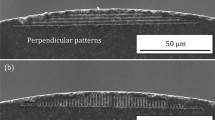Abstract
In this study, ductile mode chip formation in conventional cutting and ultrasonic vibration assisted cutting of tungsten carbide workpiece material has been investigated through experimental grooving tests using CBN tools on a CNC lathe. The experimental results show that as the depth of cut was increased there was a transition from ductile mode to brittle mode chip formation in grooving both with and without ultrasonic vibration assistance. However, the critical value of the depth of cut for ductile mode cutting with ultrasonic vibration assistance was much larger than that without ultrasonic vibration assistance. The ratio of the volume of removed material to the volume of the machined groove, f ab , was used to identify the ductile mode and brittle mode of chip formation in the grooving tests, in which f ab <1 indicates ductile mode chip formation and f ab >1 indicates brittle mode chip formation. For the same radius of tool cutting edge, the value of f ab at the ductile-brittle transition region either with or without ultrasonic vibration was less than 1. However, the f ab value with ultrasonic vibration assistance was close to 1. The experimental results demonstrate that ultrasonic vibration assisted cutting can be used to improve the ductile mode cutting performance of tungsten carbide work material.





Similar content being viewed by others
Abbreviations
- A :
-
amplitude
- A 1 , A 2 :
-
cross-section areas of the ridge
- A V :
-
cross-section area of the groove
- A W :
-
the value of A V subtracted by A 1+A 2
- f :
-
vibration frequency
- f ab :
-
ratio of work material removal
- t :
-
time
- v :
-
nominal cutting speed
- v u :
-
vibration velocity
- v t :
-
true cutting speed in ultrasonic cutting
- ω :
-
angular frequency
References
Liu K, Li XP (2001) Ductile cutting of tungsten carbide. J Mater Process Technol 113:348–354
Liu K, Li XP (2001) Modeling of ductile cutting of tungsten carbide. In: Trans NAMRI/SME XXIX:251–258
Moriwaki T, Shamoto E, Inoue K (1992) Ultraprecision ductile cutting of glass by applying ultrasonic vibration. Ann CIRP 41:141–144
Blackley WS, Scattergood RO (1994) Chip topography for ductile-regime machining of germanium. Trans ASME J Eng Ind 116:263–266
Yan J, Yoshino M, Kuriagawa T, Shirakashi T, Syoji K, Komanduri R (2001) On the ductile machining of silicon for micro electro-mechanical systems (MEMS), opto-electronic and optical applications. Mater Sci Eng A297:230–234
Fang FZ, Venkatesh VC (1998) Diamond cutting of silicon with nanometric finish. Ann CIRP 47:45–49
Fang FZ, Chen LJ (2000) Ultra-precision cutting of ZKN7 glass. Ann CIRP 49:17–20
Kim JD, Choi IH (1997) Micro surface phenomenon of ductile cutting in the ultrasonic vibration cutting of optical plastics. J Mater Process Technol 68:89–98
Kim JD, Choi IH (1998) Characteristics of chip generation by ultrasonic vibration cutting with extremely low cutting velocity. Int J Adv Manuf Technol 14:2–6
Nerubai MS (1987) Characteristics of contact interaction in ultrasonic cutting of difficult-to-machine materials. Soviet J Frict Wear 8:452–458
Lucas M, Graham G, Smith AC (1996) Enhanced vibration control of an ultrasonic cutting process. Ultrasonics 34:205–211
Astashev VK, Babitsky VI (1998) Ultrasonic cutting as a nonlinear (vibro-impact) process. Ultrasonics 36:89–96
Moriwaki T, Shamoto E (1995) Ultrasonic elliptical vibration cutting. Ann CIRP 44:31–34
Smith A, Nurse A, Graham G, Lucas M (1996) Ultrasonic cutting: a fracture mechanics model. Ultrasonics 34:197–203
Liu K, Li XP, Liang SY (2004) The mechanism of ductile chip formation in cutting of brittle materials. Adv Man Technol (in press)
Liu K, Li XP, Rahman M, Liu XD (2004) A study of the cutting in the grooving of tungsten carbide. Int J Adv Manuf Technol (in press)
Gahr ZKH (1987) Microstructure and wear of materials. Elsevier, Amsterdam
Acknowledgement
The authors would like to express their sincere thanks to Mori Seiki, Japan, for their generous donation of the CNC lathe, SL-35, to our advanced manufacturing laboratory, in which the experiments of this study were carried out.
Author information
Authors and Affiliations
Corresponding author
Rights and permissions
About this article
Cite this article
Liu, K., Li, X.P., Rahman, M. et al. Study of ductile mode cutting in grooving of tungsten carbide with and without ultrasonic vibration assistance. Int J Adv Manuf Technol 24, 389–394 (2004). https://doi.org/10.1007/s00170-003-1647-5
Received:
Accepted:
Published:
Issue Date:
DOI: https://doi.org/10.1007/s00170-003-1647-5




